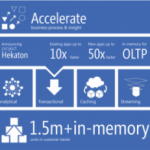Here are my personal choice of links for the week ending today.
- SQL Server:
- Courtenay Bernier’s Virtualizing SQL Server on Hyper-V and on Windows Azure VMs addresses Hyper V / Windows Server 2012 capabilities that need to be considered, when contemplating SQL Server virtualization. The article also addresses Azure as another possibility for SQL Server virtualization and covers some of the resulting limitations and advantages. Includes multiple links for additional relevant information. It’s an interesting resource to keep bookmarked.
- Bruno Terkaly’s and Ricardo’s VillaLobo’s Migrating Database Workloads to the Cloud discusses several scenarios for SQL Server migration to Azure including Windows Azure SQL Server databases or the use of an Azure VM.
- Mary Hutson’s Top Support Solutions for Microsoft SQL Server provides a considerable number of links to Microsoft’s support solutions on the most frequent issues experienced with SQL Server.
- Microsoft’s SQL Server Team’s IO Resource Governance in SQL Server 2014 addresses changes introduced to SQL Server’s Resource Governor in SQL Server 2014 and shows how the changes can be used to control resource usage in a SQL Server instance. This article was also added to my list of SQL Server 2014 links.
- Jez Schultz Borland’s Document Your SQL Server Databases with Extended Properties shows how extended properties can be used to document multiple database objects, with examples of T-SQL to create, update and delete such properties. The comments to the article also provide useful information on other ways to use extended properties for the same or other purposes, especially if you use SSDT.
- Simon Liew’s Different Ways to Restore a SQL Server Database provides examples of the multiple alternatives to restore a database using the full recovery model to a specific point in time, from the full, differential and transaction log backups available.
- Thomas LaRock’s SQL Server Plan Cache: The Junk Drawer for Your Queries explains what the SQL Server plan cache is and presents a few queries that can be used to determine plans that are similar, used only once or plans that may need tuning. Such plans can provide performance improvement opportunities and can thus be part of the tools used by a DBA to keep a server optimized for the best possible performance.
- Mark S. Rasmussen’s SQL Server Corruption Recovery – When All Else Fails presents some corruption recovery techniques, based on his own OrcaMDF, a C# MDF parser, available on GitHub. These techniques have the possibility to minimize data loss, if no other recovery strategies work or are unavailable.
- Web Design and Development:
- Julien Knebel’s An In-Depth Introduction To Ember.js is an excellent introduction to one of the most popular Javacript framework for front-end development, Ember.js. The goal of the article is to provide an easier start for developers beginning with Ember and it is very good at that.
- Lauren Orsini’s What You Need To Know About Node.js gives a few the reasons for Node.js’s increased popularity and provides a link to a good introductory tutorial.
- Andy Leverenz’s The beginner’s guide to Sass provides an easy to read guide to Sass, explaining it’s advantages, providing examples of different possible syntaxes supported and presenting Sass’s features, like variables, operations and functions, nesting and mixins.
- Dudley Storey’s Better Pop-Up Windows With JavaScript and CSS3, Part 1 is the first article in a series that addresses the design of popup windows combining the best of Javascript and CSS3.
- CJ Gammon’s Killer Responsive Layouts With CSS Regions presents Regions, a new part of the CSS specification that has been seeing increased support by more browsers. Regions features and advantages are explained and demoed, especially from a responsive design perspective. Links and suggestions for further reading are included, as well.
- The Visual Studio 2013 Resources post, includes several updates to the Visual Studio 2013 links and videos.
- Software Development:
- Ivar Jacobson et al.’s Agile and SEMAT – Perfect Partners addresses how combining SEMAT (Software Engineering Method and Theory) with Agile, can help developers and teams improve their own software development practices. A very interesting article, from the creator of Use Cases.
- Zain Naboulsi’s The Case For Agile Over Waterfall addresses the question of whether Agile still holds advantages over the classic waterfall approach to software development. The doubt was raised on the author from interactions with customers. The article presents links and data that back the idea that Agile is, of course, still advantageous, even if it seems there are many holdouts out there.
- Josh Symonds’s What Makes a Good Programmer Good? addresses some of the qualities exhibited by good programmers and I cannot but agree with him.
That’s it for this week.Thanks for reading,

